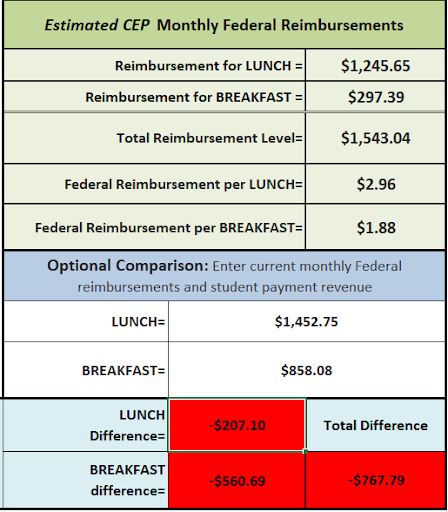
The Community Eligibility Provision, or CEP, is a federal non-pricing meal service that allows schools in low-income areas to provide free breakfast and lunch to all students without having to collect applications.
In the fall of 2023, the USDA made a final ruling amending the CEP. It states that the minimum identified student coverage (ISP) will now be 25%, instead of the previous 40%. With this announcement comes a number of questions as new schools will now be eligible and are considering if CEP is right for their program.
What should I consider before applying?
CEP is a great option, but it may only be right for some schools or districts. Decision makers must evaluate participation, administrative, and financial factors to understand the viability of transitioning to CEP. Before beginning the application process, there are a few things that you and your team should take into consideration.![]() Pros
Pros
All students receive no-cost breakfast and lunch meals
The most apparent benefit of CEP is that all students would receive free breakfast and lunch, regardless of their economic status. It also allows you to create healthier meal options for more students. If more students choose the CEP meals that have to abide by USDA guidelines, these students will be eating healthier throughout the day.
Eliminates F&R eligibility stigma
For the students themselves, it provides a great benefit in that it can create an “even playing field” and help remove or reduce the stigma attached to students who previously received free and reduced meals.
No need to collect F&R eligibility applications or conduct verification
Since CEP would apply to all students, regardless of financial status, there would be no more need to collect free & reduced applications. Since there would be no need to collect free & reduced applications, that also means that you would no longer need a local education agency (LEA) to conduct the verification process.
No more meal debt
With CEP, every student is eligible for a free meal which means there’s potential for no meal debt. Although you can still have other options in the cafeteria like a la carte items, having free meals for every student could drastically reduce the amount of meal debt. Managing meal debt has become quite a hassle for programs, so this advantage would be a welcome change for many schools.![]() Cons
Cons
Potential financial issues
There could be potential financial issues if less than 100% reimbursement is at the free rate. To calculate this number, your school or district's ISP would be multiplied by 1.6 to get the free reimbursement that you would receive. For example, if your ISP is 40% you could calculate that only 64% of your meals would be reimbursed at the free federal rate (40% multiplied by 1.6). With 64% of meals bring reimbursed at the free federal rate, that means the remaining 36% would be only be reimbursed at the paid rate. It's important to evaluate these details on how your reimbursements would be impacted under CEP in order to understand the potential affect on your program's finances.
Possible loss of funding for other district programs
As mentioned above, if your school goes CEP, you no longer need to collect information for free and reduced applications. Although that can be a positive, it can also have a negative impact if other programs in your school or district rely on the data that is collected through those applications. Without collecting applications, schools must identify other procedures to determine the economic status of individual students.
May be confusing to parents if not applied district-wide
When considering CEP, you can choose to do it by school, a group of schools, or a whole district. If only some schools qualify, it may confuse parents with students in different schools. You must have a good communication plan in place so parents are aware of the change and understand what it means for their family moving forward.
What information should I review in order to evaluate if CEP is right for my program?
Before beginning the application process, be sure to review the important information that can help you determine if it’s even a good option for your school.
Identifiable Student Coverage
In order to qualify for CEP after the new ISP is in effect, 25% of your students must qualify for free meals. That means the first piece you'll need to know if your ISP. This means knowing how many students currently are identified for free meals not using the free and reduced application, also known as directly certified students (ex., foster students, homeless students).
Program Participation
Next, it'll be important to understand what may be your projected participation under CEP. Going CEP could increase your participation, therefore increasing food costs and the potential need for increased staffing. On the other hand, if there’s potential for participation to be low, you could end up losing money instead.
Food Costs
Don’t forget to consider the food costs associated with this too. If you anticipate high levels of participation, your food costs are likely going to rise, and you may even need to increase your staffing. You should calculate your cost per meal based on your CEP rate projections.
To make things easier, the USDA has a CEP estimator tool where you can input your data to calculate your ISP and determine your funding in the future. It’s important to note that the CEP cycle is four years, so consider long-term financials as well. Here’s an example of an estimated CEP monthly federal reimbursement after the appropriate numbers have been collected using the USDA calculator. In this case, you can see the school would actually be losing money if they were to go CEP.

How will CEP impact my program technology?
After going through all these steps, if you determine that CEP is right for your school or district, you’ll have to evaluate the technology you’re using. Many programs wonder if they still need a Point of Sale after transitioning to CEP. However, your POS will still be an important part of your program's success, especially for offering and tracking a la carte sales. Your system will also help track duplicate meals and can be used to alert cashiers when a student may have chosen a meal with a known allergen.
Additionally, even under CEP, your school may still need to collect income surveys to provide for program funding. Online application programs, like MySchoolApps, can make survey collection easy and seamless for everyone involved.
For more information, check out our in-depth webinar where our experts discuss more about this new change to CEP, the information you need for evaluation, and how your POS can support your decision.








